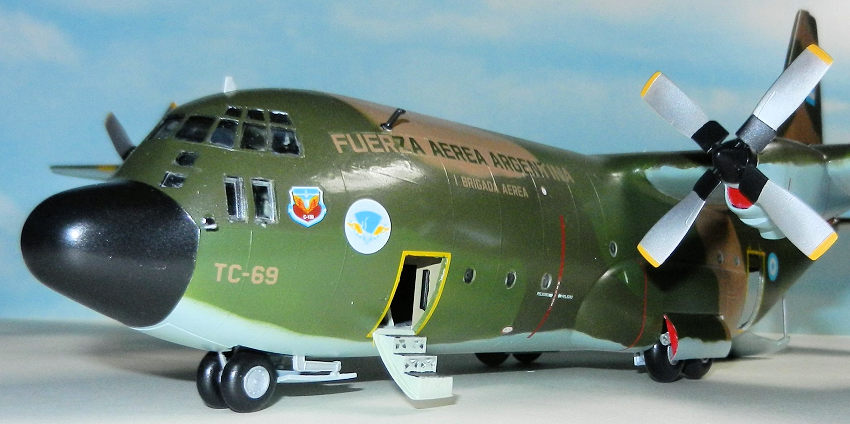
Italeri 1/72 KC-130 Hercules
| KIT #: | 09003 |
| PRICE: | CAD $30.00 |
| DECALS: | Several options |
| REVIEWER: | Pablo Calcaterra |
| NOTES: | Modified engine nacelles. . A tanker without IFR tanks |

| HISTORY |
Lockheed Hercules KC-130 TC-69
Fuerza Aérea Argentina 1982
KC-130H TC-69 (sn 382-4814) was received by the Fuerza Aérea Argentina (FAA) in May 1979. Shortly afterwards on June 12 1979 it carried out the first air to air refuelling (a flight of A-4Cs)
The historical fleet of Hercules in Argentina is as follows:
-TC-56 C-130B - SOC
-TC-57 C-130B - SOC
-TC-58 C-130B – SOC
-TC-59 C-130B - SOC
-TC-60 C-130B - SOC
-TC-61 C-130H – In service
-TC-62 C-130H – Destroyed by a remote controlled bomb planted in drain on the
runway by the communist guerrillas when taking off in Tucuman in 1975. 6 killed
out of 114 on board.
-TC-63C-130H – Shot down by Lt. Cdr. Sharkey Ward on June 1 1982 with the loss
of the entire crew (read below).
-TC-64 C-130H – In service. Dropped containers to the RI8 in the islands on May
20th.
-TC-65 C-130H - Not in service at BAM El Palomar. Canibalized for parts. Last
plane to take off from Puerto Argentino (Stanley) on the night of June 13/14
1982 breaking for the last time the air blockade. Suffered a punctured tire
during that landing. A 155 cm gun was unloaded and several injured soldiers
boarded the plane along with the Argentine flag that had flown at the air base
since April 2nd to prevent it from being captured by the British troops. All the
lights of the airport were turned on in defiance to the British troops that were
in the hills surrounding the area. The commander of the British artillery
ordered maximum range and effort to hit the clearly visible plane on the runway
but all the rounds fell short. As soon as the plane took off the lights were put
out and the Hercules performed a flat turn to avoid a British helicopter located
straight ahead in the air and that could have been waiting to shoot the Hercules
down. TC-65 landed safely back in the continent in the early hours of June 14th,
last day of the hostilities.
-TC-66 C-130H – In service
-TC-67C-130H – SCR following an accident in 1996 at BAM Tandil.
-TC-68 C-130H – Not in service and in storage at BAM El Palomar. To be retrofit at FAdeA (Fábrica Argentina de Aviones "Brigadier San Martín" S.A. - formerly known as FMA – Fábrica Militar de Aviones). First plane to land on the islands on April 2nd 1982. Dropped 8 x containers with cargo at BAM Darwin on May 19th, 1982. Converted to long range bomber that looked at attacking resupply ships of the British Task Force in 1982 as follows:
May 29: BP “British Wye” hit by an unexploded bomb and damaged
May 31: RFA “Fort Grange” attacked in fog. Not damaged but Task Force ships sailing from Ascension to the Zone ordered to take a more easterly route to avoid the surprising attacks by the Hercules of the FAA.
June 1: found a CL22 Frigate (not identified) and escaped
June 8: attacked VLCC “Hercules”. Hit by one unexploded bomb. Ship sailed to
Rio de Janeiro. After inspecting the damage it was decided to avoid the risk of
an explosion it was better to sink the ship a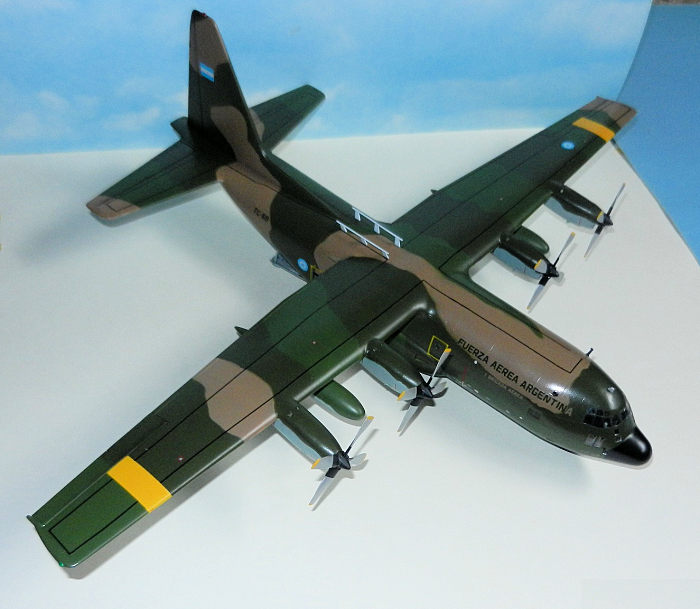 nd be paid the Insurance Policy. On
July 20th VLCC Hercules sunk 700 km east of Florianopolis, Brazil.
nd be paid the Insurance Policy. On
July 20th VLCC Hercules sunk 700 km east of Florianopolis, Brazil.
-TC-69 KC-130H – Returned to service after massive upgrades at FAdeA. Now
named PUERTO ARGENTINO in painted in low viz light grey. Subject of this
article.
-TC-70 KC-130H – In service
-TC-100 L-100-30 – In service
TC-69 in the 1982 war in the South Atlantic:
The two tankers (TC-69 and TC-70) in service in the Air Force during the war gave the attacking fighter bombers squadrons legs that allowed them to even strike the British Task Force at her core (i.e. mission flown by Super Etendards and A4-C Skyhawks on May 30 1982). Many of the missions to San Carlos or even the successful return of some hard hit planes would not have happened without the support of the affectionally called “Chanchas”. Most of the “CRUCES” (crossings to land on the islands) were flown by TC63, TC-65 and TC-68).
The missions flown by KC-130H TC-69 during the 1982 war are as follows:
May 1: From Santa Cruz it flew a cargo mission flown by Vicecomodoro Litrenta and crew (Capt. Guillermo Destefanis, Major Franciso Mensi, Cabos Principal Juan Peron, Juan TEllo, Suboficial auxiliary Hugo Gonzalez, and Vicente Reynoso, suboficial principal Andres Manyszyn, cabo primero Eduardo Barrionuevo)
May 9: during the failed attack on the Task Force (bad weather) TC-69 flew air refueling missions for the A-4Cs. Flown by Capt Ruben Martel and Capt Carlos Krause and crew.
(On May 11 TC-70 simulated a refueling mission along with two LR-35 to try to keep the Task Force under alert)
May 12: TC-69 and TC-70 flew missions to refuel the A-4Bs that attacked HMS Glasgow (hit and put out of combat) and HMS Brilliant. TC-69 was flown by Vicecomodoro Litrenta and crew.
May 21: Litrenta flew his plane on two missions to IFR. The first one started at 6:35 and finished at 12:35. The second one started at 15:15 and finished at 18:35. Heavy attacks on the Task Force at San Carlos with HMS Ardent sunk and many ships hit and damaged to varying degrees.
May 22: During this day no effective attacks were carried out but still TC-69 and Litrenta flew an IFR mission from 13:05 to 19:05.
May 23: Though many missions were planned several failed to approach San Carlos because the tankers (KCs) had been orbiting in the wrong area. One of the successful missions was the one flown by Capt Carballo (NENE). Realizing that something was wrong with the coordinates given for the IFR they flew on and found the tankers orbiting 150 miles further ahead (practically in full sight of San Carlos waters. Crews in the tankers could see far away the sun shining on the canopy of the Sea Harriers). NENE sunk HMS Antelope that day. TC-69 in particular is recorded as taking off at 8:56 and returning to Rio Grande at 17:55. NENE, TRUENO, ORO, PLATA, LANZA, TEJO from the FAA and TABANO from the CANA (Navy) were refueled by the tankers.
May 24: vicecomodoro Enrique Pessana and crew flew 2 missions on TC-69 to IFR the fighter-bombers. First one from 8:25 till 13:45 and the second from 15:30 till 20:00
May 25: the tankers were very busy. TC-69 was flown by Pessana again. During their mission they IFR the returning TORO (A4-C that had attacked HMS Avenger in San Carlos and lost 2 planes in the process) and the SuperEtendard that had attacked the Task Force from the North hitting with Exocet missiles the container ship Atlantic Conveyor that sunk some hours later. TC-69 took off from Rio Gallegos at noon and returned 18:00.
May 26: with the same crew and taking off from Comodoro Rivadavia TC-69 orbited waiting for business but no IFR took place on this day. It was a 4 hour long mission.
May 27: TC-69 and -70 flew two missions each on this day. In the case of TC-69 Pessana’s plane IFR the A-4Cs tasked with attacking the bridge (TIGRE and TANQUE) during the first mission (9:45 till 12:55) and the more successful POCKER and TRUCO (A-4B) who managed to bomb the troops in San Carlos harbor during the second one (14:00 till 18:15)
May 28: with Litrenta again at the commands TC-69 flew from 10:05 till 17:05. They refueled A-4Bs CUÑA and NENE who did not find targets at Bahia Ruiz Puente.
May 29: TC-69 and Litrenta flew two missions (from 9:05 till 13:40 and from 14:15 till 17:15). The only A-4 section on that day was ORO who did not find suitable targets during their flight over the San Carlos area.
May 30: both tankers were reserved for the most intrepid Argentine mission of
the war: the attack to the core of the Task Force with an attack from the
Southeast circumventing the islands around the South. The four A-4Cs called
ZONDA formed on and followed two Super Etendards with the last Exocet in
Argentine inventory. TC-69 was flown by vicecomodoro Litrenta and crew as
RANQUEL 1 and TC-70 (RANQUEL 2) was flown by Mayor Briend and crew. They took
off from Comodoro Rivadavia at 11:25 and returned at 17:25. On position
55º50’S/58º00’W the 6 planes refueled two times from the tankers while still
moving towards the Task Force. With tanks full and now at a point past the East
of the islands the 6 planes flew north towards the Tas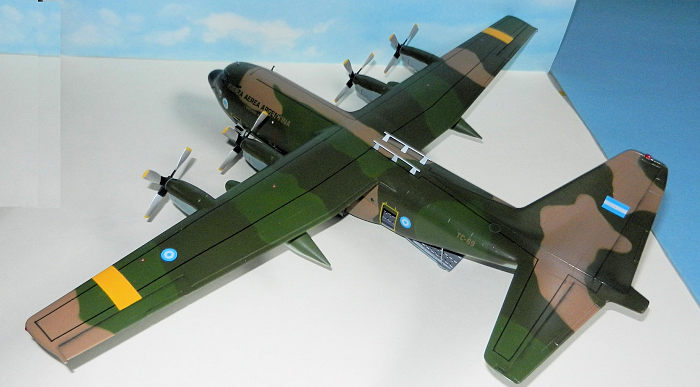 k Force approximately 140
miles away. Flying low over the ocean and forming on the SUE the A-4Cs waited
for the single Exocet to be fired. When this happened a short message from the
SUE pilot (20 miles ahead) gave the distance to the FAA pilots who now chased
the smoke trail of the missile. Two A-4Cs were lost in the attack and
contradictory versions about what happened during the attack still remain with
the Argentine survivors still claiming that HMS Invincible was hit by the Exocet
and that they dropped their 3 x 250 kg bombs on it. In the meantime, and exposed
to any Sea Harrier attack, the tankers kept orbiting now at a point just south
of the Islands waiting for the returning planes. The SUE rocked their wings
indicating that they had enough fuel to return to their base without IFR. The
surviving A-4Cs (Ureta and Isaac) found the tankers. The KC-130 kept on orbiting
waiting for the other 2 planes. When asked about their fate a saddened Ureta
answered: “Don’t wait for them”. At this, the tankers started to fly towards the
continent with the Skyhawks still attached to their refueling probes. The
surviving A-4Cs returned to Rio Grande after an almost 4 hour long mission.
k Force approximately 140
miles away. Flying low over the ocean and forming on the SUE the A-4Cs waited
for the single Exocet to be fired. When this happened a short message from the
SUE pilot (20 miles ahead) gave the distance to the FAA pilots who now chased
the smoke trail of the missile. Two A-4Cs were lost in the attack and
contradictory versions about what happened during the attack still remain with
the Argentine survivors still claiming that HMS Invincible was hit by the Exocet
and that they dropped their 3 x 250 kg bombs on it. In the meantime, and exposed
to any Sea Harrier attack, the tankers kept orbiting now at a point just south
of the Islands waiting for the returning planes. The SUE rocked their wings
indicating that they had enough fuel to return to their base without IFR. The
surviving A-4Cs (Ureta and Isaac) found the tankers. The KC-130 kept on orbiting
waiting for the other 2 planes. When asked about their fate a saddened Ureta
answered: “Don’t wait for them”. At this, the tankers started to fly towards the
continent with the Skyhawks still attached to their refueling probes. The
surviving A-4Cs returned to Rio Grande after an almost 4 hour long mission.
June 1: T-63 TIZA is shot down by Sharkey Ward while using their weather radar to look for surface (Task Force) targets. Hit by one Sidewinder and with the right wing on fire the Hercules kept on flying low and fast. A potential force landing on the ocean could have been tried but Ward approached the struggling plane and emptied his 30 mm Aden cannons on the plane. With the controls destroyed the Hercules spiraled towards the ocean where it exploded on impact with the loss of the entire crew. This did not deter the FAA and more Hercules missions to search for the enemy were flown on later days.
June 8: Bluff Cove Disaster. The tankers again had an important role on the actions of this day. TC-69 flew led by comodoro Cano and crew. Took off at 11:55 and returned to Rio Gallegos at 17:55. After IFR the several attack squadrons that successfully hit RFA Sir Gallahad, Sir Tristam, bombed the ground forces and also sunk Foxtrot 4. The badly perforated MARTILLO 3 (A-4B flown by primer teniente Sanchez) requested help to reach the tanker. Cano gave Sanchez a new set of coordinates to fly to. One of his drop tanks had not transferred all the fuel to the main tank and now he did not have enough gas to return to the continent. After flying some minutes very low to evade any potential enemy, he decided to climb to save fuel while he was calling the tanker to get close to the Islands to save him. The commander of the KC-130 asked:
-“Give me your position”
-“I don’t have it”
-“Read it in your Omega”
-“I don’t have Omega”
-“Turn on your IFF”
-“I don’t have IFF. I am standard”
This means that Sanchez aircraft had only the minimum equipment. The plane with all the navigational aids in the formation had been the leader’s, C-204 (shot down and killer earlier in the mission)
The tanker got close to the island while losing height and Sanchez was flying west, gaining height. Finally, the Hercules started to leave a condensation trail as it changed to a colder air layer. Sanchez saw the trail when he had less than 500 lb of fuel left in his tanks and turned towards his salvation. Flying too fast, he overtook the tanker and had to turn very sharp to try again. He was able to connect his probe to the tankers’ refueling basket. The commander of the KC-130 exclaimed: “You are safe!” but they could hear Sanchez distressed voice saying: “No sir, it’s not worth it this way. I have lost my 3 companions…” Having topped up his tanks, Sanchez returned to Rio Gallegos safely, the only survivor of this mission.
Having fed the damaged Skyhawk with most of their fuel (as it was exiting the fighter bomber thru the multiple holes) the tanker almost run out of fuel and had an emergency when the nose wheel failed to lock.
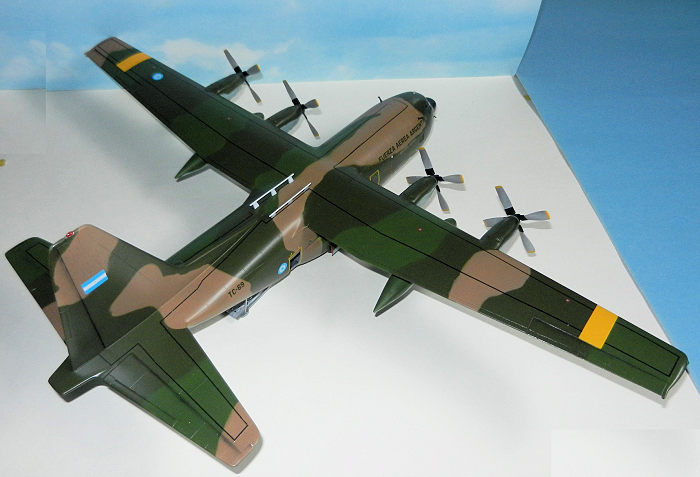 June 9: More missions were flown by Skyhawks to the Bluff Cove area. They did
not find anything but some planes developed fuel leaks that necessitated the
help of TC-69 (vicecomodoro Noe and crew). They brought COBRA 1 and 2 hooked to
the hoses all the way to San Julian where the Skyhawks managed to land. TC-69
took off from Rio Gallegos at 13:15 and returned at 17:25.
June 9: More missions were flown by Skyhawks to the Bluff Cove area. They did
not find anything but some planes developed fuel leaks that necessitated the
help of TC-69 (vicecomodoro Noe and crew). They brought COBRA 1 and 2 hooked to
the hoses all the way to San Julian where the Skyhawks managed to land. TC-69
took off from Rio Gallegos at 13:15 and returned at 17:25.
June 12: TC-69 flew as OMBU2 with major Briend at the commands. They refueled a couple of A-4Bs that were looking for naval targets without success. Took off from Rio Gallegos at 12:35 and returned 15:45.
June 13: Attack to the ground forces at mount Kent was undertaken by 2 x 4 sections of Skyhawks. TC-69 with vicecomodoro Litrenta took off from Rio Gallegos at 9:15 to support the attack planes. After bombing the ground troop concentrations with mixed results the Skyhawks escaped back to the continent. Two of these were hard hit: C-222 flown by Capt Varela (see my article) and C-221 flown by alferez Dellepiane. This one was a dramatic return.
With only 2,000 lb left when he would have needed 4,500 lb to make it back to the continent Dellpiane started to climb towards the West. In order to save fuel he slowed down and when over San Carlos Waters he had 1,600 lb left. The controller in Puerto Argentino/Stanley informed him that the Harriers were far away. Wondering what to do (eject or keep on) and with all his squadron mates giving him advice over the radio (called to silence by Capt. Varela) he decided to fly on when he had 900 lb left (for you to understand how little he had left a Skyhawk consumes 500 lb from start to take off). Dellepiane called for help and Litrenta answered:
-“Don’t worry lad, we will head towards the islands right now!” Litrenta asked jokingly if Dellepiane needed something else…
Now flying over the ocean and having left the islands behind the Hercules crew gave Dellepiane “optimistic” numbers in terms of distance between them. Dellepiane would count on the radio for the Hercules to home on him. He was being supported all the time (“Go on, lad, you will make it!”)
Dellepiane kept on praying while the other pilots were telling him that he was almost there. With only 300 lb left and hearing his friends in a much comfortable (fuel) situation Dellepiane exclaimed: “ Some are so lucky!”
The dialogue between Litrenta and the Skyhawk pilot continued this way: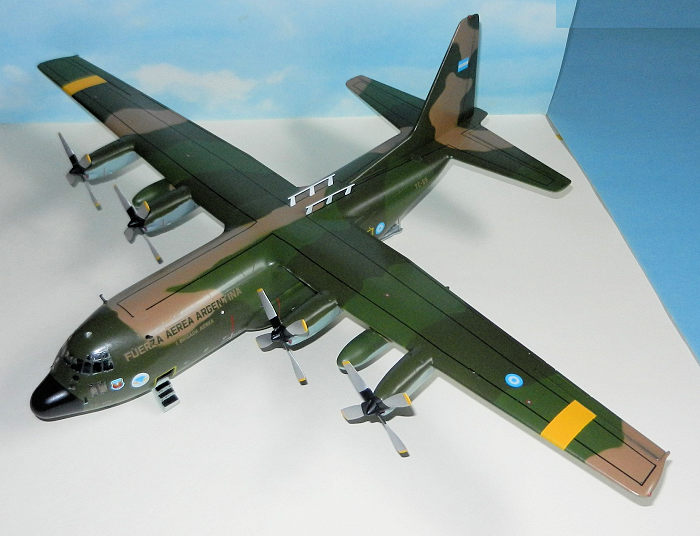
-“I only have 300 lb”
-“You have more than enough, stay calm”
-“It will only last for 10 more minutes in flight!”
-“You have more than enough with that, we are almost there”
-“I have 200 lb left! Cacho (Litrenta’s nickname) don’t leave me!” while he touched a chocolate and box of cigarettes that Capt. Carballo had given him as a present before the mission. He thought that at least he was going enjoy them before dying.
-“Piano (Dellepiane’s nickname), where would you be able to glide to if your engine stops?”
-“The middle of the ocean”
-“How much gas do you have left?”
-“200 lb!”
-“Ah!...more than enough with that!”
-“I said 200, not 2,000!!!!” came Dellepiane’s answer.
When he was down to 150 lb Litrenta saw a Skyhawk and asked Dellepiane to rock his wings to make sure it was him…but it was Cervera.
-“No, it’s not you”. Dellepiane’s heart sunk.
With 100 lb and the gauge marking almost zero Litrenta said:
“-I believe we have you. Turn right, you have to see us!”
There they were, the Hercules was lower and to his right. His gauge now was reading zero. Thinking he was not going to make it Dellepiane accelerated and dove towards the tanker while asking them to turn to make it easier to engage the refueling probe.
“-I am giving it all, full throttle to catch you up!” said Dellepiane
“-Well done lad, you are a brave man!” came the answer.
Dellepiane had over done it and he was approaching the tanker too fast. He asked the tanker to dive.
“-Diving for a looping!” Litrenta answered.
When almost there Dellepiane extended the airbrakes and in his first try connected his refueling probe to the tankers. At the same time he could hear the Argentine fighter pilots war cry: “Y no hay quien pueda!!” (No one can against us). He could also see thru the window of the tanker that the crew where jumping and hugging each other celebrating.
The gauge finally started to climb. Everyone was congratulating him over the radio.
When he landed he descended from the plane as soon as possible. A large pool of fuel was forming under the plane. From there he went straight to Mass.
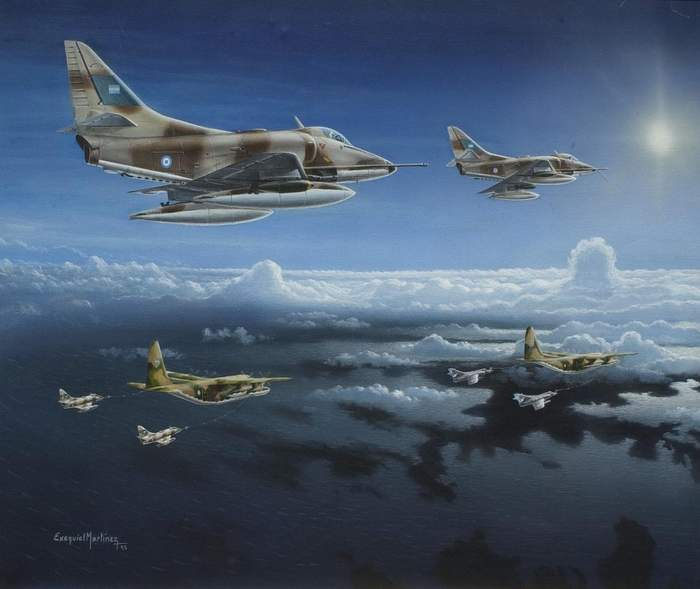 Shortly after the war Dellepiane found Litrenta and very emotional told him
that from then onwards he was going to call him DAD. And to this day, every time
they meet, the Piano calls Cacho “DAD” (papá)
Shortly after the war Dellepiane found Litrenta and very emotional told him
that from then onwards he was going to call him DAD. And to this day, every time
they meet, the Piano calls Cacho “DAD” (papá)
To finalize, some numbers to show the value of the Hercules during the conflict.
Famous air bridges in number of days:
Dien Bien Phu:78 days, Khe Sanh: 78 days, Malvinas (Falklands): 74 days.
Missions to break the blockage flown by the FAA: 61 (31 successfully landed, 2 air drops, 28 failed to land due to tactical conditions); Passengers: 9,729, Cargo: 5,442 MT, Flown by the FAA: 2,047hours, Flown by commercial airlines: aprox 310 hours, Hercules crews: 15 teams.
After the war:
TC-69 was one of the two planes from the FAA that participated in the Allied effort of the First Gulf War in 1990/91. On January 10th they took an Argentine Navy Alouette III to replace one that had been damaged. When about to land in Riyadh they were intercepted by 4 fighters that identified them, rocked the wings and left them to land. Most of the missions (125 hs in total) flown by the plane were nocturnal so after the war a Batman logo was painted on the nose of the plane.
Latest news:
Early 2016 the plane was received by the FAA with several improvements: satellite communication devices, Flight 2 avionics from Rockwell Collins, APN-241 radar from Northrop Grumman among others that include a low biz cammo and the words PUERTO ARGENTINO painted besides the left side nose crew access door.
| THE KIT |
Raised panel lines are all over this kit which is actually a C-130 A (short engine nacelles). There are parts to build several versions (Australian, British with refueling probe, Sweden) so these can be a good source of spares for the box. The decals sheet is as large as the box and beautifully printed. Regretfully for my project most of them went unused. Instructions are good but lacking in detail in regards to correct placement and angle of some parts (probes, sensors, etc)
| CONSTRUCTION |
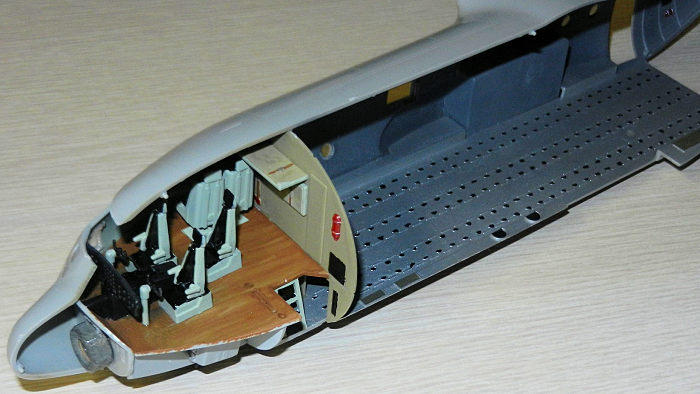 As normal I started with the cockpit. There are several versions and
configurations and I had a hard time finding the correct one for the Argentine
version. I decided to put one of the stretchers opened and the other one
stored/folded. I followed the instructions from Italieri for the colours that
seemed to match the few references I could find for the FAA (Fuerza Aérea
Argentina) planes.
As normal I started with the cockpit. There are several versions and
configurations and I had a hard time finding the correct one for the Argentine
version. I decided to put one of the stretchers opened and the other one
stored/folded. I followed the instructions from Italieri for the colours that
seemed to match the few references I could find for the FAA (Fuerza Aérea
Argentina) planes.
I glued a large nut behind the front wall of the cockpit as it would sit inside the nose. The fuselage interior is quite scant in terms of detail. I just followed the instructions for assembly and painting and that is all I was willing to do without incurring in extra costs to purchase a kit to detail it. All the door openings were sealed using masking tape inside the fuselage.
I closed the fuselage halves with the cargo doors set in place with blue tack and masking tape. Fit was quite good and a little bit of filler was required to bridge some differences in the height of the sides. With this I was forced to re-scribe some panel lines (now they would be engraved along the center of the fuselage)
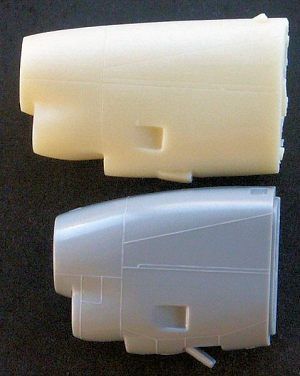 Next a small self-made catastrophe happened. After dry fitting and testing
several times the main windows and finding that fit was very tight I put the
glue on the grey plastic and slid the clear part. The glue rippled up and
overlapped the inside of the clear windows in 3areas. The following day I found
that my hopes had been in vain…these 3 areas were not clear anymore but white
burnt plastic.
Next a small self-made catastrophe happened. After dry fitting and testing
several times the main windows and finding that fit was very tight I put the
glue on the grey plastic and slid the clear part. The glue rippled up and
overlapped the inside of the clear windows in 3areas. The following day I found
that my hopes had been in vain…these 3 areas were not clear anymore but white
burnt plastic.
Next were the engines. I found a picture of the correction kit (Flighpath)
that had the short and long nacelles side by side. With this as a reference I
cut the nacelles in 3 and inserted 4 pieces of plasticard between the back and
middle of the engine and 2 more between the middle and front part. With these
glued and dry I started the painful process of shaping the exceeding
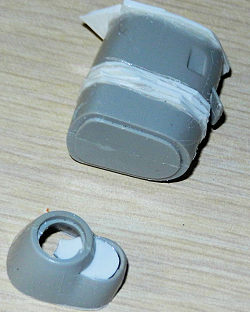 pieces of
plastic into the walls of the nacelle. It took multiple long and boring sessions
to accomplish a good result (panel lines had to be rescribed as well). The
intake of the engine is just an open hole and I covered the 4 of them with
plastic card to simulate the closing lid that I eventually painted in red.
pieces of
plastic into the walls of the nacelle. It took multiple long and boring sessions
to accomplish a good result (panel lines had to be rescribed as well). The
intake of the engine is just an open hole and I covered the 4 of them with
plastic card to simulate the closing lid that I eventually painted in red.
With the wings put together these were then attached to the fuselage. More putty was required here and there (and more panel lines were re scribed). Next were the horizontal tail planes that also required putty. I sprayed all the puttied areas with aluminum paint to check for opportunities for improvement. The landing gear had been installed and now the wells were covered with damped tissue paper. All square windows were masked with Tamiya tape and all the round ones using little balls of blue tac.
| COLORS & MARKINGS |
I used ModelMaster Acrylic paints. First I used Light blue RLM65 for all the undersurfaces, followed by Tan (4709), then Medium Green (4734) and finally Dark Green (4726). The lines between colours are smooth so I used Blue Tac to obtain the desired effect. The yellow (4683) ID bands were painted on wings only. Thanks to Claudio Garcia I did not repeat his mistake and I did not paint a yellow ID band on the tail.
The nose was painted black along with the propeller hubs and the area behind the exhausts. Propeller blades were aluminum with yellow tips. A cotton Q tip was used to spread sanded charcoal along the moveable surfaces.
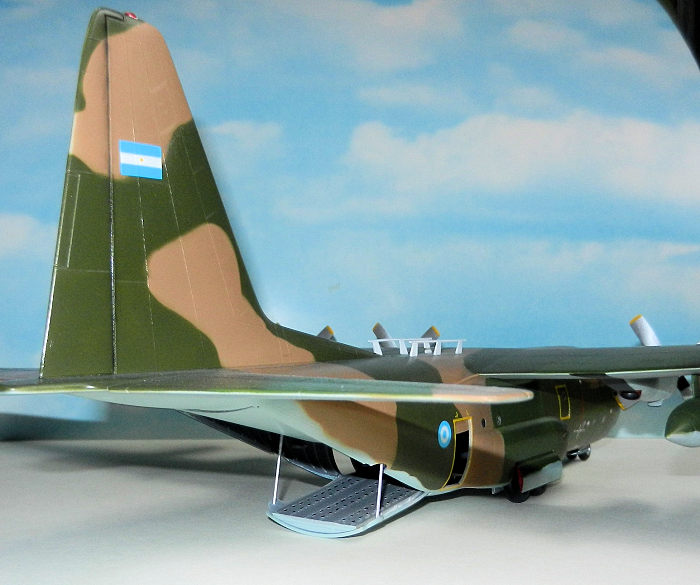 Future gave a gloss surface for the decals: a mix of Italieri (long black no
walk lines, emergency escape hatches on top of the fuselage) and AeroCalcas for
Argentine stencils in Spanish and red lines for the engines, yellow around the
doors, tail numbers. At this point I discovered a critical mistake in my paint
scheme: even though I had printed to scale the pattern and affixed it to the
plane while doing the different colours it turned out that the green where the
FUERZA AEREA ARGENTINA words are located was not high enough. I faced two
options:
Future gave a gloss surface for the decals: a mix of Italieri (long black no
walk lines, emergency escape hatches on top of the fuselage) and AeroCalcas for
Argentine stencils in Spanish and red lines for the engines, yellow around the
doors, tail numbers. At this point I discovered a critical mistake in my paint
scheme: even though I had printed to scale the pattern and affixed it to the
plane while doing the different colours it turned out that the green where the
FUERZA AEREA ARGENTINA words are located was not high enough. I faced two
options:
Remove the future, correct the green taking it higher and then Future it again or struggle with the decals achieving a not so perfect finished product. I went with the second option…
I don’t know why I purchased 2 sets of the same Aerocalcas decals but it proved to be a great help. They gave me enough bits of green letters to painfully cut them, shape them and place them on top of the (invisible) light tan letters. I had to take some of the Dagger also included in the same set. Thru a 3 night session I was able to reconstruct the words...now in dark green. When all decals were dry I wiped the excess of glue and gave the plane a coat of SemiGloss Acrylic Clear paint.
| FINAL CONSTRUCTION |
After removing all the masking from the windows I had to fix the situation with the white burnt main windshields. I first though about painting them all black (anyways little is to be seen thru them). Then I decided to mix black with Future to dilute it. It worked to an extent but it still looked too dark. I removed the mix from the windows before it dried and added now some light grey to the mix. I applied it again and I was gladly surprised with the end result: the windows are still clear, the white areas cannot be seen anymore and the final look is quite good as you can see in the pictures!
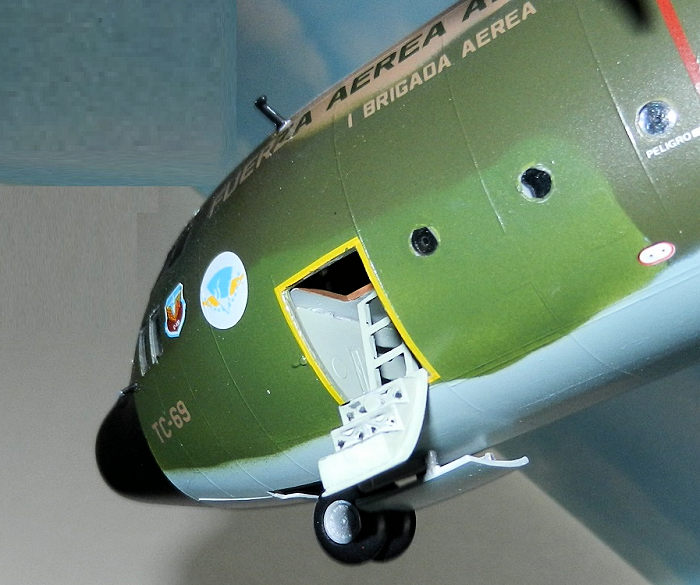 Cargo doors were now glued in place, propellers attached, miscellaneous
antennas and probes attached. Wheels and landing gear doors were installed (the
main ones include a scratch-built landing light on each door) as were the
external tanks in between the engines on each wing.
Cargo doors were now glued in place, propellers attached, miscellaneous
antennas and probes attached. Wheels and landing gear doors were installed (the
main ones include a scratch-built landing light on each door) as were the
external tanks in between the engines on each wing.
I found now that the plane was a tail sitter…or almost. Just in case I added an extra piece of lead (those ones you can buy at you local hobby shop that have tape on one side) by making it slide on the floor of the plane and then putting it on it’s nose. The lead flipped 90 degrees and stuck to the wall…not nice but efficient!
The final bit was to install the small doors on the side. I had no clue about how they are positioned when open (I wanted as much light on the plane as possible). Thanks to Scott who sent me a picture I was able to slide the doors and glue them almost fully opened.
| CONCLUSIONS |
The only part the kit does not have to represent a KC versions are the 2 refueling pods. I had to leave my model without these. Painfully and slowly I nevertheless succeeded in finishing a very large kit that in 1/72nd (not my scale) is practically as big as a 1/48th B-17! With this one now I have in my collection practically every single significant plane in the FAA inventory during the 1982 war.
My tribute to the “Transporteros” who flew in unarmed planes and managed to carry out their missions in spite of the total blockade imposed by the British Task Force.
Thanks to Vicecomodoro Luis Litrenta for his inspiration to build his plane, Exequiel Martinez, like always, for his paintings to illustrate my articles, and Carlos A. García
| REFERENCES |
Historia Oficial de la Fuerza Aerea, Volumen 6 (Malvinas), Book 1 and 2
Dios y los Halcones (comodoro (R) Pablo Carballo)
No apagues la luz cuando te vayas (comodoro (R) Ruben Horacio Cabanillas)
Puente Aereo a Malvinas (Brigadier Mayor (R) Ruben Palazzi)
Taringa.net (Los Hercules de la Fuerza Aerea Argentina)
El Hercules bombardero en el Conflicto de Malvinas – Indicativo Tigre (comodoro Cerruti – Boletin de Direccion de Estudios Historicos 7/2016)
29 March 2017
Copyright ModelingMadness.com
If you would like your product reviewed fairly and fairly quickly, please contact the editor or see other details in the Note to Contributors.
Back to the Main Page Back to the Review Index Page Back to the Previews Index Page